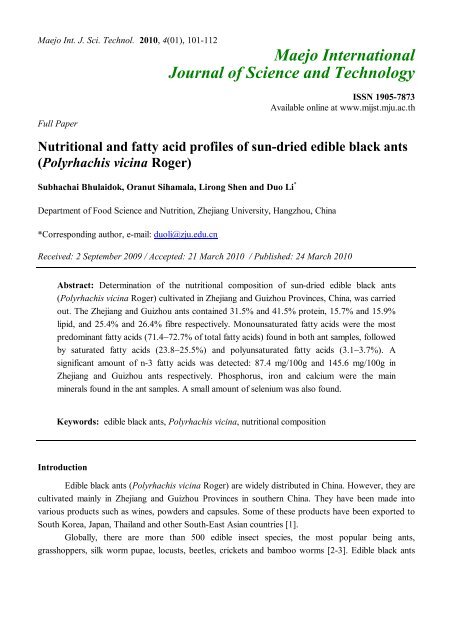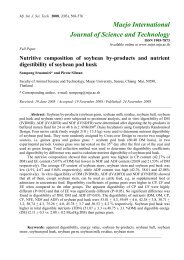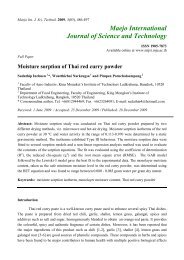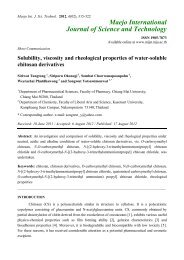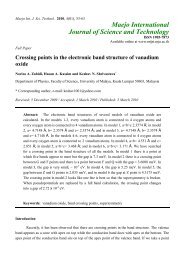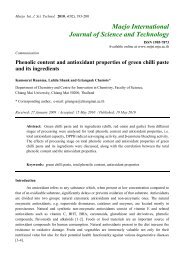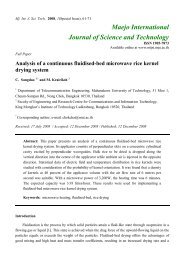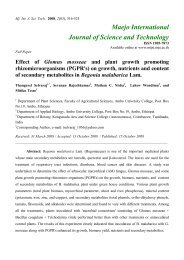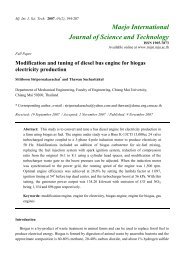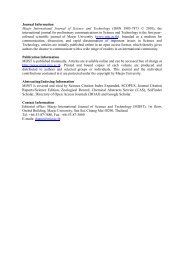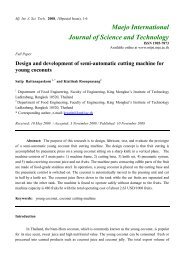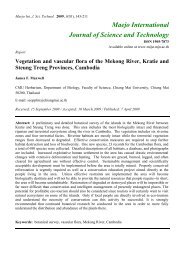Nutritional and fatty acid profiles of sun-dried edible black ants
Nutritional and fatty acid profiles of sun-dried edible black ants
Nutritional and fatty acid profiles of sun-dried edible black ants
You also want an ePaper? Increase the reach of your titles
YUMPU automatically turns print PDFs into web optimized ePapers that Google loves.
Maejo Int. J. Sci. Technol. 2010, 4(01), 101-112<br />
Full Paper<br />
Maejo International<br />
Journal <strong>of</strong> Science <strong>and</strong> Technology<br />
ISSN 1905-7873<br />
Available online at www.mijst.mju.ac.th<br />
<strong>Nutritional</strong> <strong>and</strong> <strong>fatty</strong> <strong>acid</strong> <strong>pr<strong>of</strong>iles</strong> <strong>of</strong> <strong>sun</strong>-<strong>dried</strong> <strong>edible</strong> <strong>black</strong> <strong>ants</strong><br />
(Polyrhachis vicina Roger)<br />
Subhachai Bhulaidok, Oranut Sihamala, Lirong Shen <strong>and</strong> Duo Li *<br />
Department <strong>of</strong> Food Science <strong>and</strong> Nutrition, Zhejiang University, Hangzhou, China<br />
*Corresponding author, e-mail: duoli@zju.edu.cn<br />
Received: 2 September 2009 / Accepted: 21 March 2010 / Published: 24 March 2010<br />
Abstract: Determination <strong>of</strong> the nutritional composition <strong>of</strong> <strong>sun</strong>-<strong>dried</strong> <strong>edible</strong> <strong>black</strong> <strong>ants</strong><br />
(Polyrhachis vicina Roger) cultivated in Zhejiang <strong>and</strong> Guizhou Provinces, China, was carried<br />
out. The Zhejiang <strong>and</strong> Guizhou <strong>ants</strong> contained 31.5% <strong>and</strong> 41.5% protein, 15.7% <strong>and</strong> 15.9%<br />
lipid, <strong>and</strong> 25.4% <strong>and</strong> 26.4% fibre respectively. Monounsaturated <strong>fatty</strong> <strong>acid</strong>s were the most<br />
predominant <strong>fatty</strong> <strong>acid</strong>s (71.472.7% <strong>of</strong> total <strong>fatty</strong> <strong>acid</strong>s) found in both ant samples, followed<br />
by saturated <strong>fatty</strong> <strong>acid</strong>s (23.825.5%) <strong>and</strong> polyunsaturated <strong>fatty</strong> <strong>acid</strong>s (3.13.7%). A<br />
significant amount <strong>of</strong> n-3 <strong>fatty</strong> <strong>acid</strong>s was detected: 87.4 mg/100g <strong>and</strong> 145.6 mg/100g in<br />
Zhejiang <strong>and</strong> Guizhou <strong>ants</strong> respectively. Phosphorus, iron <strong>and</strong> calcium were the main<br />
minerals found in the ant samples. A small amount <strong>of</strong> selenium was also found.<br />
Keywords: <strong>edible</strong> <strong>black</strong> <strong>ants</strong>, Polyrhachis vicina, nutritional composition<br />
Introduction<br />
Edible <strong>black</strong> <strong>ants</strong> (Polyrhachis vicina Roger) are widely distributed in China. However, they are<br />
cultivated mainly in Zhejiang <strong>and</strong> Guizhou Provinces in southern China. They have been made into<br />
various products such as wines, powders <strong>and</strong> capsules. Some <strong>of</strong> these products have been exported to<br />
South Korea, Japan, Thail<strong>and</strong> <strong>and</strong> other South-East Asian countries [1].<br />
Globally, there are more than 500 <strong>edible</strong> insect species, the most popular being <strong>ants</strong>,<br />
grasshoppers, silk worm pupae, locusts, beetles, crickets <strong>and</strong> bamboo worms [2-3]. Edible <strong>black</strong> <strong>ants</strong>
Maejo Int. J. Sci. Technol. 2010, 4(01), 101-112<br />
have been used as human food <strong>and</strong> health food for hundreds <strong>of</strong> years in China [4]. They are an<br />
important cheap source <strong>of</strong> high-protein food in rural areas. In China, <strong>edible</strong> <strong>black</strong> <strong>ants</strong> have been<br />
extensively studied <strong>and</strong> shown to have many pharmacological properties such as anti-cancer, antifatigue<br />
<strong>and</strong> anti-inflammatory [5].<br />
Sun drying is a common traditional method for drying fresh <strong>ants</strong>; it is still used in <strong>edible</strong> <strong>black</strong><br />
ant processing industries in China. The fresh <strong>ants</strong> are put in water or in a freezer at -20C <strong>and</strong> then were<br />
<strong>sun</strong> <strong>dried</strong>. While a few studies have investigated the nutrition composition <strong>of</strong> hot-air-<strong>dried</strong> <strong>black</strong> <strong>ants</strong><br />
[67], for <strong>sun</strong>-<strong>dried</strong> <strong>ants</strong> which are commonly eaten, there is limited information on their nutritive value.<br />
In the present study, therefore, the determination <strong>of</strong> the nutritional composition <strong>of</strong> <strong>sun</strong>-<strong>dried</strong> <strong>edible</strong><br />
<strong>black</strong> <strong>ants</strong> is carried out.<br />
Materials <strong>and</strong> Methods<br />
Sample preparation<br />
The cultivated adult <strong>edible</strong> <strong>black</strong> <strong>ants</strong> (Polyrhachis vicina) were collected in Zhejiang <strong>and</strong><br />
Guizhou Provinces, China, in June 2006. The fresh <strong>ants</strong> were stored at -20C overnight, then <strong>sun</strong> <strong>dried</strong><br />
for 3 days (10 h/day) <strong>and</strong> powdered with mortar <strong>and</strong> pestle until homogeneous.<br />
Sampling<br />
For each experiment, three samples were r<strong>and</strong>omly collected from different batches <strong>of</strong> <strong>sun</strong><br />
drying.<br />
Proximate analysis<br />
All solvents used were <strong>of</strong> analytical grade or HPLC grade <strong>and</strong> were purchased from Merck<br />
(Darmstadt, Germany) or Sigma-Aldrich (Steinheim, Germany). Crude protein, crude lipid, ash, crude<br />
fibre <strong>and</strong> moisture content were determined using the st<strong>and</strong>ard methods <strong>of</strong> the AOAC [8]. Crude<br />
protein was determined by the micro-Kjeldahl procedure; the factor N 6.25 was used to convert<br />
nitrogen into crude protein. Results were calculated as per cent <strong>of</strong> dry weight (DW). Crude lipid content<br />
was obtained by the Soxhlet extraction method using petroleum ether as solvent. Ash content was<br />
obtained by heating the sample at 550C to constant weight. Moisture content was determined by<br />
heating the sample to constant weight at 105C. Crude fibre was determined gravimetrically after<br />
chemical digestion <strong>and</strong> solubilisation <strong>of</strong> other materials present. The fibre residual weight was then<br />
corrected for ash content after ignition. Carbohydrate content was estimated by subtracting the sum <strong>of</strong><br />
the weights <strong>of</strong> crude protein, crude lipid, ash <strong>and</strong> crude fibre from the total dry matter.<br />
Amino <strong>acid</strong> analysis<br />
Determination <strong>of</strong> amino <strong>acid</strong> pr<strong>of</strong>ile was conducted according to the st<strong>and</strong>ard AOAC methods<br />
[8]. The ground ant sample was hydrolysed in 6 N HCl at 110C under nitrogen atmosphere for 24 h.<br />
The hydrolysed solution was used in the determination <strong>of</strong> free amino <strong>acid</strong>s with a Hitachi L8800<br />
102
Maejo Int. J. Sci. Technol. 2010, 4(01), 101-112<br />
(Hitachi, Japan) automatic amino <strong>acid</strong> analyser. The results were reported as milligrams <strong>of</strong> amino <strong>acid</strong><br />
per 100 g <strong>of</strong> protein.<br />
Fatty <strong>acid</strong> analysis<br />
An oil sample for <strong>fatty</strong> <strong>acid</strong> analysis was obtained according to a previous study with<br />
modification [9]. Approximately 2 g <strong>of</strong> well-ground <strong>sun</strong>-<strong>dried</strong> ant sample were extracted with 20.0 mL<br />
<strong>of</strong> chlor<strong>of</strong>orm–methanol (2:1,v/v) containing 10 mg/L <strong>of</strong> butylated hydroxyl toluene (BHT) <strong>and</strong> 0.9<br />
mg/mL <strong>of</strong> C19:0 (nonadecanoic <strong>acid</strong>) as internal st<strong>and</strong>ard. Then, the mixture was stored in the fume<br />
hood for 24 h, then filtered <strong>and</strong> transferred to a separating funnel <strong>and</strong> added with 0.9% sodium chloride<br />
(10 mL). After shaking, the phases were allowed to separate <strong>and</strong> the separated lower phase was then<br />
concentrated at 38C <strong>and</strong> transferred to a 10-mL volumetric flask <strong>and</strong> made up to volume with<br />
chlor<strong>of</strong>orm containing 10 mg/L <strong>of</strong> BHT. The total oil content was determined by evaporating <strong>of</strong>f the<br />
solvent at 38C under N2 to constant weight.<br />
The <strong>fatty</strong> <strong>acid</strong> methyl esters (FAMEs) <strong>of</strong> the total lipid extract were prepared by<br />
transesterification using 0.9M H2SO4 in methanol [10]. Briefly, lipid solution (1 mL), 0.9M H2SO4 in<br />
methanol (3 mL) <strong>and</strong> toluene (1 mL) were added to a Teflon-capped tube <strong>and</strong> the mixture shaken<br />
strongly, then submerged in water bath at 70C for 2 h. Then n-hexane (2 mL) <strong>and</strong> 0.9% sodium<br />
chloride (1 mL) were added to the tube <strong>and</strong> centrifuged at 1200 rpm for 15 min. The supernatant was<br />
then dropped into water (2 mL) <strong>and</strong>, after separating <strong>of</strong>f the aqueous phase, <strong>dried</strong> with a little sodium<br />
sulphate anhydrous. The crude FAMEs solution obtained was filtered through a Sep-pak silica column<br />
(Alltech Associates, Inc., Deerfield, IL) before injection into the gas chromatograph, which is a<br />
Shimadzu GC-14C system equipped with a flame ionisation detector (Shimadzu Corp., Kyoto, Japan), a<br />
fused silica capillary column (DB-23, 60m0.248mm0.25μm: Agilent Technologies, Inc., Palo Alto,<br />
CA, USA) <strong>and</strong> the N2010 Chromatography Data System (Zhida Information Technologies, Inc.,<br />
Hangzhou, China). Injection <strong>and</strong> detection temperature was 270C <strong>and</strong> 270C respectively. The column<br />
temperature was kept at 100C for 3 min <strong>and</strong> programmed to 190C at a rate <strong>of</strong> 20C/min <strong>and</strong> kept at<br />
190C for 10 min. It was then increased to 205C at a rate <strong>of</strong> 5 C/min <strong>and</strong> kept at 205C for 6 min.<br />
Finally, it was increased to 230C at a rate <strong>of</strong> 10C/min <strong>and</strong> kept at 230C for 5 min. Individual <strong>fatty</strong><br />
<strong>acid</strong>s were identified by means <strong>of</strong> purified st<strong>and</strong>ards (Sigma-Aldrich, Deisenh<strong>of</strong>en, Germany) <strong>and</strong><br />
quantified by means <strong>of</strong> the internal st<strong>and</strong>ard method [11].<br />
Mineral analysis<br />
Sun-<strong>dried</strong> ant samples were subjected to <strong>acid</strong> digestion <strong>and</strong> analysed according to the procedure<br />
described by Farías et al. [12] with modification. A sample <strong>of</strong> ant powder (2 g) was ashed in a muffle<br />
furnace for 4 h at 550C. After cooling, HNO3 (30 mL), H2O2 (2 mL) <strong>and</strong> HClO4 (5 mL) were added.<br />
Then the mixture was boiled to near dryness. The residue was added with doubly distilled water (10<br />
mL) <strong>and</strong> filtered. Then it was diluted with doubly distilled water to a volume <strong>of</strong> 100 mL <strong>and</strong> used for<br />
analysis. Mineralogical analysis was carried out using ICP emission spectroscopy (IRIS Intrepid II XSP,<br />
103
Maejo Int. J. Sci. Technol. 2010, 4(01), 101-112<br />
Thermo Elemental Corporation, USA). All determinations were performed in triplicate <strong>and</strong> data<br />
represented on a dry weight basis as mean values ± st<strong>and</strong>ard deviation.<br />
Statistical analysis<br />
All experiments were performed in triplicate. The design was completely r<strong>and</strong>omised [13]. The<br />
data were compared by one-way analysis <strong>of</strong> variance (ANOVA), <strong>and</strong> the mean values were compared<br />
by least squares difference method with SPSS 16.0 program. Significance was set as p
Maejo Int. J. Sci. Technol. 2010, 4(01), 101-112<br />
Amino <strong>acid</strong> pr<strong>of</strong>ile<br />
The amino <strong>acid</strong> composition <strong>of</strong> the <strong>sun</strong>-<strong>dried</strong> <strong>ants</strong> is shown in Table 2. Eighteen amino <strong>acid</strong>s<br />
were detected in both Zhejiang <strong>and</strong> Guizhou <strong>ants</strong>, similar to previous reports for hot-air-<strong>dried</strong> <strong>ants</strong> [6-<br />
7]. The major amino <strong>acid</strong>s in both Zhejiang <strong>and</strong> Guizhou <strong>sun</strong>-<strong>dried</strong> ant proteins are glycine <strong>and</strong> glutamic<br />
<strong>acid</strong>, <strong>and</strong> the least abundant ones are cysteine <strong>and</strong> methionine. The proportion <strong>of</strong> a few amino <strong>acid</strong>s<br />
(threonine, valine, lysine, phenylalanine, tryptophan, serine, glycine, arginine, proline <strong>and</strong> histidine)<br />
seems to be significantly influenced by the location <strong>of</strong> the <strong>ants</strong>. Ants need a nutritional source <strong>of</strong><br />
arginine, histidine, leucine, isoleucine, lysine, methionine, phenylalanine, threonine, trythophan <strong>and</strong><br />
valine, which is the same as for human young [18]. Total essential amino <strong>acid</strong> content in Guizhou <strong>ants</strong> is<br />
significantly higher than that in Zhejiang <strong>ants</strong>, which may be attributable to difference in amino <strong>acid</strong><br />
content in the feed for the <strong>ants</strong>. Nevertheless, the amino <strong>acid</strong> <strong>pr<strong>of</strong>iles</strong> <strong>of</strong> the Zhejiang <strong>and</strong> Guizhou <strong>sun</strong><strong>dried</strong><br />
<strong>ants</strong> are similar, their essential amino <strong>acid</strong> content being 34.6% <strong>and</strong> 36.1% respectively <strong>of</strong> the total<br />
protein, which is similar to that in egg (38.8% <strong>of</strong> total protein) [19] but substantially higher than that <strong>of</strong><br />
Hangzhou hot-air-<strong>dried</strong> <strong>ants</strong> (18.1% <strong>of</strong> total protein) [7]. Also, the protein <strong>of</strong> the <strong>sun</strong>-<strong>dried</strong> <strong>ants</strong> has a<br />
higher proportion <strong>of</strong> methionine, valine, lysine, threonine, isoleucine, leucine, phenylalanine <strong>and</strong><br />
tryptophan than that <strong>of</strong> the Hangzhou hot-air-<strong>dried</strong> <strong>ants</strong>. These results seem to imply that there is a<br />
protein <strong>and</strong> amino <strong>acid</strong> loss probably caused by the Maillard reactions during the hot-air drying process<br />
[20] whereas <strong>sun</strong> drying does not induce as much loss <strong>of</strong> amino <strong>acid</strong>s in the <strong>ants</strong>.<br />
Fatty <strong>acid</strong> composition<br />
The <strong>sun</strong>-<strong>dried</strong> <strong>ants</strong> are rich in lipid. The composition <strong>and</strong> concentration <strong>of</strong> <strong>fatty</strong> <strong>acid</strong>s in the <strong>sun</strong><strong>dried</strong><br />
ant oil are presented in Tables 3-4. Twenty-two <strong>and</strong> 23 <strong>fatty</strong> <strong>acid</strong>s are identified in Guizhou <strong>and</strong><br />
Zhejiang ant oil respectively. Unsaturated <strong>fatty</strong> <strong>acid</strong>s vary between 74.5-76.4% with monounsaturated<br />
<strong>fatty</strong> <strong>acid</strong>s (MUFA) <strong>and</strong> polyunsaturated <strong>fatty</strong> <strong>acid</strong>s (PUFA) ranging between 71.4-72.7% <strong>and</strong> 3.1-<br />
3.7% respectively. As a result, <strong>sun</strong>-<strong>dried</strong> ant samples could be a good source <strong>of</strong> unsaturated <strong>fatty</strong> <strong>acid</strong>s.<br />
The 16:0 <strong>fatty</strong> <strong>acid</strong> is found as the major saturated <strong>fatty</strong> <strong>acid</strong> while the 18:1 <strong>acid</strong> is the main MUFA<br />
(60.5-63.0%).<br />
The n-3 PUFA are known to prevent cardiovascular disease [21] <strong>and</strong> are anti-inflammatory [22].<br />
Total PUFA content (n-3 + n-6) is higher in Guizhou than in Zhejiang <strong>ants</strong>. Since both groups <strong>of</strong> <strong>ants</strong><br />
feed on similar diet (such as insects, larvae <strong>and</strong> algae), the difference, though small, in the proportions<br />
<strong>of</strong> their PUFA <strong>and</strong> total unsaturated <strong>fatty</strong> <strong>acid</strong>s could possibly be attributed to the climate factor [23-<br />
25], the average annual temperature in Guizhou Province being lower than that in Zhejiang Province.<br />
The 18:3(n-3) is the main n-3 PUFA in both Zhejiang <strong>and</strong> Guizhou <strong>ants</strong>, amounting to 63.0 mg <strong>and</strong><br />
123.5 mg per 100 g <strong>of</strong> total <strong>fatty</strong> <strong>acid</strong>s respectively. With the quantities <strong>of</strong> total n-3 PUFA being as they<br />
are (Tables 3-4), the Zhejiang <strong>and</strong> Guizhou <strong>sun</strong>-<strong>dried</strong> <strong>ants</strong> can be utilised as a source <strong>of</strong> these <strong>fatty</strong><br />
<strong>acid</strong>s. It has been recommended that human beings evolve on a diet with n-3/n-6 ratio <strong>of</strong> approximately<br />
1 [26-27]. High ratio <strong>of</strong> n-3/n-6 is advantageous for reducing the risk <strong>of</strong> cardiovascular diseases [26-<br />
27]. In this study, the ratio <strong>of</strong> n-3/n-6 is found to be 0.41 <strong>and</strong> 0.42 for Zhejiang <strong>and</strong> Guizhou <strong>sun</strong>-<strong>dried</strong><br />
105
Maejo Int. J. Sci. Technol. 2010, 4(01), 101-112<br />
<strong>ants</strong> respectively. These <strong>ants</strong> are also a good source <strong>of</strong> unsaturated <strong>fatty</strong> <strong>acid</strong>s which are beneficial to<br />
human health.<br />
Table 2. Amino <strong>acid</strong> composition (mg/100g crude protein) <strong>of</strong> <strong>edible</strong> <strong>black</strong> ant samples<br />
Amino <strong>acid</strong> Zhejiang <strong>sun</strong>-<strong>dried</strong><br />
<strong>ants</strong><br />
Essential amino<br />
<strong>acid</strong>s<br />
Threonine<br />
Valine<br />
Methionine<br />
Isoleucine<br />
Leucine<br />
Lysine<br />
Phenylalanine<br />
Tryptophan<br />
Total essential<br />
amino <strong>acid</strong>s<br />
Non-essential<br />
amino <strong>acid</strong>s<br />
Aspartic <strong>acid</strong><br />
Serine<br />
Glutamic <strong>acid</strong><br />
Glycine<br />
Alanine<br />
Tyrosine<br />
Arginine<br />
Proline<br />
Cysteine<br />
Histidine<br />
Total non-essential<br />
amino <strong>acid</strong>s<br />
4016.7±1.3 a<br />
6883.3±1.5 a<br />
1626.7±1.3<br />
4650.0±2.1<br />
6973.3±2.1<br />
4370.0±1.7 b<br />
3340.0±1.9 a<br />
2736.7±1.4 b<br />
34596.7±1.6 a<br />
7516.7±1.6<br />
4823.3±0.8 a<br />
11206.7±1.6<br />
12860.0±1.3 b<br />
9483.3±1.5<br />
5340.0±1.7<br />
3523.3±1.6 a<br />
7366.7±1.0 b<br />
696.7±1.5<br />
2580.0±1.2 b<br />
65396.7±1.6 b<br />
Guizhou <strong>sun</strong>-<strong>dried</strong><br />
<strong>ants</strong><br />
4263.3±1.3 b<br />
8273.3±1.4 b<br />
2326.7±1.1<br />
4570.0±2.0<br />
6980.0±2.0<br />
3736.7±1.4 a<br />
3496.7±1.1 b<br />
2460.0±1.5 a<br />
36106.7±2.2 b<br />
7756.7±1.8<br />
5106.7±1.3 b<br />
11570.0±1.4<br />
11596.7±2.1 a<br />
8843.3±1.0<br />
5330.0±1.2<br />
3790.0±1.0 b<br />
6766.7±1.1 a<br />
730.0±1.5<br />
2396.7±2.0 a<br />
63886.8±1.8 a<br />
Hangzhou hot-<br />
air-<strong>dried</strong> <strong>ants</strong><br />
(Shen et al.[7])<br />
2260.0<br />
3430.0<br />
1190.0<br />
2260.0<br />
3920.0<br />
2200.0<br />
1760.0<br />
1120.0<br />
18140.0<br />
5050.0<br />
2940.0<br />
7450.0<br />
5690.0<br />
4540.0<br />
2820.0<br />
2730.0<br />
2830.0<br />
3390.0<br />
ND<br />
37440.0<br />
Egg<br />
(Wang [19])<br />
4470.0<br />
5420.0<br />
2810.0<br />
4880.0<br />
8110.0<br />
6590.0<br />
4820.0<br />
1720.0<br />
38820.0<br />
8920.0<br />
6720.0<br />
12130.0<br />
3020.0<br />
5030.0<br />
3810.0<br />
5700.0<br />
3380.0<br />
2090.0<br />
1900.0<br />
52700.0<br />
Note: Values are means ± st<strong>and</strong>ard deviations (n=3). Values having different superscript letters in a<br />
row differ significantly at p
Maejo Int. J. Sci. Technol. 2010, 4(01), 101-112<br />
Table 3. Fatty <strong>acid</strong> composition (as % <strong>of</strong> total <strong>fatty</strong> <strong>acid</strong>s) <strong>of</strong> <strong>sun</strong>-<strong>dried</strong> <strong>edible</strong> <strong>black</strong> <strong>ants</strong><br />
Fatty <strong>acid</strong> Zhejiang <strong>ants</strong> Guizhou <strong>ants</strong><br />
12:0<br />
14:0<br />
15:0<br />
16:0<br />
17:0<br />
18:0<br />
20:0<br />
22:0<br />
24:0<br />
Total SFA<br />
14:1<br />
15:1<br />
16:1<br />
17:1<br />
18:1<br />
20:1<br />
22:1<br />
Total MUFA<br />
16:2 (n-6)<br />
18:2 (n-6)<br />
20:2 (n-6)<br />
20:4 (n-6)<br />
Total n-6<br />
18:3 (n-3)<br />
20:5 (n-3)<br />
22:5 (n-3)<br />
Total n-3<br />
Total PUFA<br />
PUFA:SFA<br />
n-3/n-6<br />
0.7±0.3<br />
0.6±0.1<br />
0.2±0.1<br />
19.0±1.1<br />
0.1±0.1<br />
4.3±0.2<br />
0.2±0.1<br />
0.3±0.1<br />
0.1±0.1<br />
25.5±1.0<br />
0.1±0.1<br />
0.2±0.1<br />
8.9±0.2<br />
0.5±0.4<br />
60.5±0.8<br />
0.1±0.1<br />
1.1±0.2<br />
71.4±1.3<br />
0.3±0.1<br />
1.7±0.1<br />
0.1±0.1<br />
0.1±0.1<br />
2.2±0.7<br />
0.6±0.2<br />
0.2±0.2<br />
0.1±0.1<br />
0.9±0.3<br />
3.1±0.6<br />
0.12<br />
0.41<br />
0.6±0.3<br />
0.6±0.1<br />
0.2±0.1<br />
17.6±0.2<br />
0.1±0.1<br />
4.1±0.5<br />
0.3±0.1<br />
0.3±0.1<br />
ND<br />
23.8±1.8<br />
0.1±0.1<br />
0.1±0.1<br />
8.2±0.2<br />
0.3±0.1<br />
63.0±0.3<br />
0.1±0.1<br />
0.9±0.1<br />
72.7±1.2<br />
0.3±0.1<br />
2.0±0.1<br />
0.1±0.2<br />
0.2±0.1<br />
2.6±0.8<br />
0.9±0.1<br />
0.1±0.1<br />
0.1±0.1<br />
1.1±0.4<br />
3.7±0.7<br />
Note: Values are means ± st<strong>and</strong>ard deviations (n=3); ND = not detected, SFA = saturated <strong>fatty</strong> <strong>acid</strong>s,<br />
MUFA = monounsaturated <strong>fatty</strong> <strong>acid</strong>s, PUFA = polyunsaturated <strong>fatty</strong> <strong>acid</strong>s<br />
0.16<br />
0.42<br />
107
Maejo Int. J. Sci. Technol. 2010, 4(01), 101-112<br />
Table 4. Fatty <strong>acid</strong> concentration (mg/100 g) in <strong>sun</strong>-<strong>dried</strong> <strong>edible</strong> <strong>black</strong> ant oils<br />
Fatty <strong>acid</strong> Zhejiang <strong>sun</strong>-<strong>dried</strong> ant oil Guizhou <strong>sun</strong>-<strong>dried</strong> ant oil<br />
12:0<br />
14:0<br />
15:0<br />
16:0<br />
17:0<br />
18:0<br />
20:0<br />
22:0<br />
24:0<br />
Total SFA<br />
14:1<br />
15:1<br />
16:1<br />
17:1<br />
18:1<br />
20:1<br />
22:1<br />
Total MUFA<br />
16:2n-6<br />
18:2n-6<br />
20:2n-6<br />
20:4n-6<br />
Total n-6<br />
18:3n-3<br />
20:5n-3<br />
22:5n-3<br />
Total n-3<br />
Total PUFA<br />
66.1±1.8<br />
64.6±1.0<br />
24.0±1.7<br />
1935.7±1.4<br />
12.8±1.2<br />
441.0±1.3<br />
22.1±1.6<br />
30.9±1.9<br />
5.5±1.3<br />
2602.7±1.4<br />
11.8±1.8<br />
16.5±1.1<br />
898.9±1.6<br />
47.6±1.6<br />
6118.9±1.6<br />
9.8±1.4<br />
111.2±1.7<br />
7214.7±1.8<br />
24.8±1.4<br />
169.0±1.3<br />
7.3±1.7<br />
14.3±1.4<br />
215.4±1.9<br />
63.0±1.7<br />
17.6±1.5<br />
6.8±1.7<br />
87.4±1.5<br />
302.8±1.2<br />
80.0±1.2<br />
82.3±1.6<br />
23.1±1.9<br />
2410.7±1.4<br />
17.8±1.7<br />
562.8±1.2<br />
40.7±1.9<br />
34.5±1.6<br />
ND<br />
3251.9±1.2<br />
8.2±1.1<br />
7.3±0.6<br />
1114.8±1.7<br />
41.8±1.8<br />
8612.8±1.6<br />
11.1±1.6<br />
127.1±1.8<br />
9923.1±1.3<br />
39.1±1.2<br />
276.8±1.4<br />
12.9±1.3<br />
21.2±1.5<br />
350.0±1.2<br />
123.5±1.5<br />
13.9±1.7<br />
8.2±1.1<br />
145.6±1.7<br />
495.6±1.7<br />
Note: Values are means ± st<strong>and</strong>ard deviations (n=3); ND = not detected, SFA = saturated <strong>fatty</strong> <strong>acid</strong>s,<br />
MUFA = monounsaturated <strong>fatty</strong> <strong>acid</strong>s, PUFA = polyunsaturated <strong>fatty</strong> <strong>acid</strong>s<br />
108
Maejo Int. J. Sci. Technol. 2010, 4(01), 101-112<br />
Mineral composition<br />
The mineral content <strong>of</strong> the <strong>sun</strong>-<strong>dried</strong> <strong>ants</strong> is shown in Table 5. The most abundant mineral in<br />
both <strong>sun</strong>-<strong>dried</strong> <strong>ants</strong> is phosphorus <strong>and</strong> the least abundant is selenium. Evidently, <strong>sun</strong>-<strong>dried</strong> <strong>ants</strong> are rich<br />
in phosphorus, iron <strong>and</strong> calcium. Iron content in Zhejiang <strong>ants</strong> is significantly higher than that in<br />
Guizhou <strong>ants</strong> while for calcium content the opposite is true. This may be ascribed partly to the<br />
difference in mineral content in their feeds. It is also noted that the relative proportion <strong>of</strong> the major<br />
minerals found in this investigation is substantially different from that obtained for oven-<strong>dried</strong> <strong>ants</strong> [7].<br />
It can be concluded, however, that <strong>sun</strong>-<strong>dried</strong> <strong>ants</strong> are a good source <strong>of</strong> many important minerals such as<br />
phosphorus, calcium, iron <strong>and</strong> selenium. Iron can be antioxid<strong>ants</strong> [28] while magnesium <strong>and</strong> zinc can<br />
prevent cardiomyopathy <strong>and</strong> growth retardation [29]. Selenium is an essential component in several<br />
major metabolic pathways including thyroid hormone metabolism, <strong>and</strong> also has other important<br />
biological functions such as antioxidative <strong>and</strong> immune regulating functions [30] <strong>and</strong> anti-cancer<br />
activities [31].<br />
Table 5. Mineral content (mg/100g <strong>of</strong> <strong>sun</strong>-<strong>dried</strong> <strong>ants</strong>)<br />
Mineral Zhejiang <strong>ants</strong> Guizhou <strong>ants</strong> Hangzhou hot-air-<strong>dried</strong><br />
<strong>ants</strong> [7]<br />
Phosphorus<br />
Iron<br />
Calcium<br />
Magnesium<br />
Manganese<br />
Zinc<br />
Copper<br />
Lead<br />
Nickel<br />
Chromium<br />
Selenium<br />
387.7±1.7<br />
118.0±1.1 b<br />
49.1±0.7<br />
65.3±1.3<br />
25.9±1.0 a<br />
17.6±1.1 b<br />
2.4±0.5<br />
0.4±0.1 a<br />
Maejo Int. J. Sci. Technol. 2010, 4(01), 101-112<br />
Acknowledgements<br />
The authors acknowledge support from Rajamangala University <strong>of</strong> Technology Isan, Kalasin<br />
Campus, Thail<strong>and</strong> in the form <strong>of</strong> a research scholarship. The authors also thank the Zhejiang Shikang<br />
Biotech Co., TCD, Wenzhou <strong>and</strong> the Hangzhou Tianma Exploration Company <strong>of</strong> Animals <strong>and</strong> Pl<strong>ants</strong>,<br />
Hangzhou, Zhejiang Province, China for supplying the ant samples used in this study.<br />
References<br />
1. L. R. Shen <strong>and</strong> Y. C. Ren, “Advances on exploration <strong>and</strong> utilization <strong>of</strong> the <strong>edible</strong> <strong>and</strong> medical <strong>ants</strong><br />
in China”, Entomol. Knowledge, 1999, 36, 251254.<br />
2. United Nations, “Edible insects provide food for thought”,<br />
http://www.scoop.co.nz/stories/WO0802/S00211.htm (Accessed: 1 December 2008)<br />
3. G. R. DeFoliart, “Insects as food: Why the western attitude is important”, Annu. Rev. Entomol.,<br />
1999, 44, 2150.<br />
4. Z. C. Wu, “Ant <strong>and</strong> ant therapy”, Shanghai Publishing House <strong>of</strong> Scientific Popularizing, Shanghai<br />
(China), 1994.<br />
5. J. Kou, Y. Ni, N. Li, J. Wang, L. Liu <strong>and</strong> Z-H. Jiang, “Analgesic <strong>and</strong> anti-inflammatory activities <strong>of</strong><br />
total extract <strong>and</strong> individual fractions <strong>of</strong> Chinese medicinal <strong>ants</strong> Polyrhachis lamellidens”, Biol.<br />
Pharm. Bull., 2005, 28, 176180.<br />
6. S. L. Li, Y. J. Ren, X. Cui, Z. S. Qian <strong>and</strong> Q. Dong, “Analysis <strong>of</strong> nutritional components in<br />
Formica sanguinea Latr. <strong>and</strong> Polyrhachis vicina Roger”, J. Chinese Pharm., 1994, 29, 521522.<br />
7. L. R. Shen, D. Li, F. Q. Feng <strong>and</strong> Y. Ren, “<strong>Nutritional</strong> composition <strong>of</strong> Polyrhachis vicina Roger<br />
(Edible Chinese <strong>black</strong> ant)”, Songklanakarin J. Sci. Technol., 2006, 28 (Suppl.1), 107114.<br />
8. P. Cunniff (Ed.), “Official Methods <strong>of</strong> Analysis <strong>of</strong> AOAC International”, 16th Edn., AOAC<br />
International, Arlington V.A., 1995.<br />
9. L-F. Yang, S. Siriamornpun <strong>and</strong> D. Li, “Polyunsaturated <strong>fatty</strong> <strong>acid</strong> content <strong>of</strong> <strong>edible</strong> insects in<br />
Thail<strong>and</strong>”, J. Food Lipids, 2006, 13, 277285.<br />
10. H. Li, F-Q. Feng, L-R. Shen, Y. Xie <strong>and</strong> D. Li, “<strong>Nutritional</strong> evaluation <strong>of</strong> different bacterial<br />
douchi”, Asia Pac. J. Nutr., 2007, 16 (Suppl 1), 215221.<br />
11. H. T. Slover <strong>and</strong> E. Lanza, “Quantitative analysis <strong>of</strong> food <strong>fatty</strong> <strong>acid</strong>s by capillary gas<br />
chromatography”. J. Am. Oil Chem. Soc., 1979, 56, 933943.<br />
12. S. Farías, S. P. Arisnabarreata, C. Vodopivez <strong>and</strong> P. Smichowski, “Levels <strong>of</strong> essential <strong>and</strong> potential<br />
toxic metals in Antarctic macro algae”, Spectrochim. Acta Part B, 2002, 57, 2133–2140.<br />
13. W. G. Cochran <strong>and</strong> G. M. Cox, “Experimental Designs”, John Wiley <strong>and</strong> Sons Inc, New York,<br />
1975, pp. 95–100.<br />
14. L. Fachruddin, “A variety <strong>of</strong> beef jerky making”, Kanisius, Yogyakarta, 1997. (In Indonesian)<br />
110
Maejo Int. J. Sci. Technol. 2010, 4(01), 101-112<br />
15. J. Salvin, D. R. Jacobs <strong>and</strong> L. Marquart, “Whole grain consumption <strong>and</strong> chronic disease: Protective<br />
mechanisms”, Nutr. Cancer, 1997, 27, 1421.<br />
16. T. Wu <strong>and</strong> L. Mao, “Influences <strong>of</strong> hot air drying <strong>and</strong> microwave drying on nutritional <strong>and</strong> odorous<br />
properties <strong>of</strong> grass carp (Ctenopharyngodon idellus) fillets”, Food Chem., 2008, 110, 647653.<br />
17. V. Vadivel <strong>and</strong> K. Janardhanan, “The nutritional <strong>and</strong> anti-nutritional attributes <strong>of</strong> sword bean<br />
[Canavalia gladiata (Jacq) DC.]: An underutilized tribal pulse from south India”, Int. J. Food Sci.<br />
Tech., 2004, 39, 917926.<br />
18. H. Genç, “General principles <strong>of</strong> insect nutritional ecology”, Trakya Univ. J. Sci., 2006, 7, 5357.<br />
19. G. Y. Wang, “Table <strong>of</strong> Food Ingredients (Representative Values in China)”, People’s Sanitation<br />
Press, Beijing, 1991, pp.7879.<br />
20. M. T. García-Arias, E. Álvarez-Pontes, M. C. García-Linares, M. C. García-Fernández <strong>and</strong> F. J.<br />
Sánchez-Muniz, “Grilling <strong>of</strong> sardine fillets. Effects <strong>of</strong> frozen <strong>and</strong> thawed modality on their protein<br />
quality”, LWT-Food Sci. Technol., 2003, 36, 763769.<br />
21. F. B. Hu, L. Bronner, W. C. Willett, M. J. Stampfer, K. M. Rexrode, C. M. Albert, D. Hunter <strong>and</strong><br />
J. E. Manson, “Fish <strong>and</strong> omega-3 <strong>fatty</strong> <strong>acid</strong> intake <strong>and</strong> risk <strong>of</strong> coronary heart disease in women”, J.<br />
Am. Med. Assoc., 2002, 287, 18151821.<br />
22. A. P. Simopoulos, “Omega-3 <strong>fatty</strong> <strong>acid</strong>s in inflammation <strong>and</strong> autoimmune diseases”, J. Am. Coll.<br />
Nutr., 2002, 21, 495505.<br />
23. K. Uysal, M. Bülbül, M. Dönmez <strong>and</strong> A. K. Seçkin, “Changes in some components <strong>of</strong> the muscle<br />
lipids <strong>of</strong> three fresh water fish species under natural extreme cold <strong>and</strong> temperate conditions”, Fish<br />
Physiol. Biochem., 2008, 34, 455463.<br />
24. S. I. Kiyashko, A. B. Imbs, T. Narita, V. I. Svetashev <strong>and</strong> E. Wada, “Fatty <strong>acid</strong> composition <strong>of</strong><br />
aquatic insect larvae Stictochironomus pictulus (Diptera: Chironomidae): Evidence <strong>of</strong> feeding upon<br />
methanotrophic bacteria”, Comp. Biochem. Physiol. B Biochem. Mol. Biol., 2004, 139, 705–711.<br />
25. G. V. Skuladottir, H. B. Schioth, E. Gudmundsdottir, B. Richards <strong>and</strong> L. Jonsson, “Fatty <strong>acid</strong><br />
composition <strong>of</strong> muscle heard <strong>and</strong> liver lipids in Atlantic Salmon, Salmo Salar, at extremely low<br />
environmental temperature”, Aquaculture, 1990, 84, 71–80.<br />
26. P. M. Herold <strong>and</strong> J. E. Kinsella, “Fish oil consumption <strong>and</strong> decreased risk <strong>of</strong> cardiovascular<br />
disease: A comparison <strong>of</strong> findings from animal <strong>and</strong> human feeding trials”, Am. J. Clin. Nutr., 1986,<br />
43, 566598.<br />
27. A. P. Simopoulos, “The importance <strong>of</strong> the ratio <strong>of</strong> omega-6/omega-3 essential <strong>fatty</strong> <strong>acid</strong>s”,<br />
Biomed. Pharmacother., 2002, 56, 356379.<br />
28. J. L. Buss, F. M. Torti <strong>and</strong> S. V. Torti, “The role <strong>of</strong> iron chelation in cancer therapy”, Curr. Med.<br />
Chem., 2003, 10, 10211034.<br />
29. V. C. Chaturvedi, R. Shrivastava <strong>and</strong> R. K. Upreti, “Viral infections <strong>and</strong> trace elements: A complex<br />
interaction”, Curr. Sci., 2004, 87, 15361554.<br />
30. K. M. Brown <strong>and</strong> J. R. Arthur, “Selenium, selenoproteins <strong>and</strong> human health”, Publ. Health Nutr.,<br />
2001, 4, 593599.<br />
111
Maejo Int. J. Sci. Technol. 2010, 4(01), 101-112<br />
31. M. P. Rayman, “Selenium in cancer prevention: A review <strong>of</strong> the evidence <strong>and</strong> mechanism <strong>of</strong><br />
action”, Proc. Nutr. Soc., 2005, 64, 527542.<br />
© 2010 by Maejo University, San Sai, Chiang Mai, 50290 Thail<strong>and</strong>. Reproduction is permitted for<br />
noncommercial purposes.<br />
112


